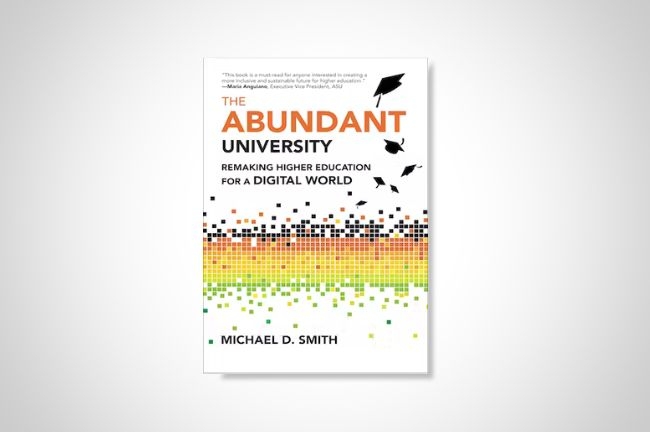You have /5 articles left.
Sign up for a free account or log in.

MIT Press
The Abundant University: Remaking Higher Education for a Digital World by Michael D. Smith
Published in September 2023
Our online education community needs more faculty champions like Professor Michael Smith. In The Abundant University, Smith (a professor of information technology and public policy at Carnegie Mellon University) has written a passionate defense of all things online learning.
Written for both a higher education and a general audience, The Abundant University frames its argument for universities by prioritizing online learning as a moral imperative. Smith synthesizes the research of Raj Chetty finding that children from households in the top 1 percent of the income distribution are 77 times more likely to attend an Ivy League college than those whose parents are in the bottom quintile.
Building on Chetty’s research, that low-income graduates of elite universities have similar earning outcomes as graduates from high-income families, Smith argues that highly selective universities should do whatever they can to increase the number of low-income students they educate. Online learning, Smith points out, is an effective mechanism for growing the supply of elite college slots, as physical classrooms and residence halls are at capacity.
The central premise of The Abundant University builds on Smith’s research on technology and the entertainment industry. This research, synthesized in Smith’s and a co-author’s excellent 2016 book, Streaming, Sharing, Stealing: Big Data and the Future of Entertainment, unpacks how the transition from scarcity to abundance in delivering information is upending traditional media business models.
In my review of Smith’s earlier book, I asked,
“Can we imagine a different model of credentialing and education—one that leverages abundant bandwidth and ubiquitous screens—that might eliminate the scarcities on which our institutions depend?”
In The Abundant University, Smith has taken me up on this question. Of course, he has the advantage of an intense six years of higher education change during a global pandemic and the pivot to remote learning. He argues that universities are ripe for structural disruption, in which the affordances of digital platforms enable institutions to fundamentally redesign how they educate and credential learners.
While not claiming that online education is superior to residential education in all cases and for all learners, Smith vigorously defends the potential quality and cost savings that online learning can provide. Through examples such as Southern New Hampshire’s low-cost online degree portfolio (over 170,000 online students) and the affordable nondegree credentials offered by platform companies such as Coursera, Smith argues that online education can break the scarcity model that defines our existing postsecondary system.
Today, the argument for universities to invest in traditional online programs has essentially been won. Every university I know, including elite universities, is rapidly rolling out new online degree programs. This change is most apparent at the master’s level, as only a very few of these degree programs offer an ROI that justifies a student quitting their job and moving their family close to campus.
A far more interesting and controversial development within higher education and an area that I wish The Abundant University had tackled with more nuance and insight is the growth of scaled online programs. These are online degree programs that are significantly less expensive than traditional degrees (usually under $30,000) and that endeavor to make the economics of the programs work by admitting large numbers of students.
These scaled online programs often include lower friction for students to apply and be admitted and options to use prior nondegree certificate experience to accelerate degree completion and lower costs. Scaled degree programs are developed and taught differently than traditional online courses and programs, as large enrollments require universities to innovate on instructional staffing models.
There is a solid case to be made that elite universities can do both traditional high-cost/high-touch teaching (residential and online) and introduce low-cost scaled online programs. The Abundant University would have been stronger if it had spent more time examining the challenges of nonprofit universities in collaborating with for-profit companies such as Coursera and 2U (which acquired edX for $800 million in 2021). While some elite institutions have been able to go to online scale without partnering with a for-profit platform provider (see Georgia Tech), many universities find it challenging to reach scale on their own.
My final critique of The Abundant University is that Smith loses an opportunity to connect residential and online learning. One of the most important outcomes of the growth of online education has been the advancement of face-to-face teaching. Online learning has been the mechanism by which many universities were able to recruit learning designers and other nonfaculty educators to our campuses. I wish Smith had spent more time speaking to learning designers and educational developers, as his arguments in The Abundant University for institutions to focus on growing their online footprints would have been more persuasive.
You are correct if you think all this critique of The Abundant University reads like so much inside baseball. Smith has written an engaging and informative book that situates the argument for growing a university’s online footprint squarely on moral and ethical territory. The book effectively negates many of the counterarguments regarding online learning (such as quality concerns) and makes the case for online education’s cost savings and access benefits.
We need more professors like Michael Smith to get interested enough in online learning that they will learn enough to support our work and maybe even consider shifting their scholarly agenda to this field of inquiry.
What are you reading?




